1. Component views
Front final drive (φ194 mm {7.64 in})
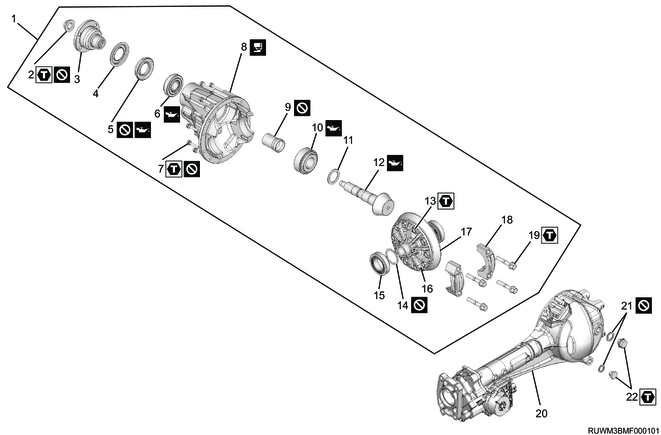
Part name
- Front final drive
- Flange nut
- Flange
- Dust cover
- Oil seal
- Outer bearing
- Bolt
- Differential carrier
- Collapsible distance piece
- Inner bearing
- Adjust shim
- Drive pinion
- Bolt
- Adjust shim
- Side bearing
- differential cage assembly
- Ring gear
- Bearing cap
- Bolt
- Front drive axle
- Gasket
- Filler plug and drain plug
Tightening torque
2: 177 to 275 N・m { 18.0 to 28.0 kgf・m / 131 to 203 lb・ft }
7: 26 N・m { 2.7 kgf・m / 19 lb・ft }
13: 108 N・m { 11.0 kgf・m / 80 lb・ft }
19: 98 N・m { 10.0 kgf・m / 72 lb・ft }
22: 50 N・m { 5.1 kgf・m / 37 lb・ft }
2. Shift on the fly system safety information
When assembling, if nothing in particular is specified, refer to the following and apply or add shift-on-the-fly system oil.
Refer to "201.General Information 14B.Vehicle Information recommended fluids, lubricants and diesel fuels".
3. Final drive installation
1) Clean the mating surfaces of the front drive axle and differential carrier.
2) Apply ThreeBond 1215 or equivalent to the mating surface of the front drive axle and differential carrier.
3) Install the final drive to the front drive axle.
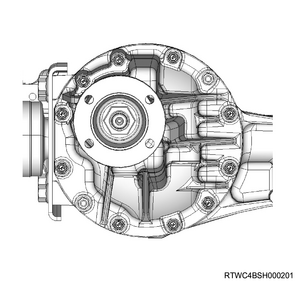
Caution
- Do not reuse the bolt.
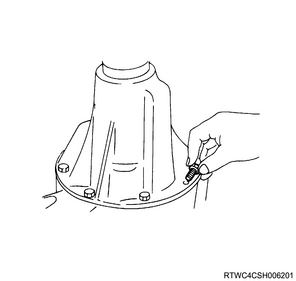
Tightening torque: 26 N・m { 2.7 kgf・m / 19 lb・ft }
4. Inner drive shaft installation
1) Clean the housing contact surface of the front axle case.
2) Install the inner drive shaft to the front axle case.
Caution
- Install so that the inner drive shaft is not damaged.
3) Install the snap ring to the front axle case groove.
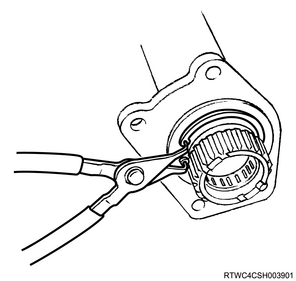
4) Apply shift-on-the-fly system oil to the sleeve.
5) Install the sleeve to the axle shaft.
5. Clutch gear installation
1) Apply shift-on-the-fly system oil to the clutch gear.
2) Install the clutch gear to the inner drive shaft.
3) Apply differential oil to the sleeve.
4) Install the sleeve to the inner drive shaft.
5) Remove any old sealing agent from the following parts.
- Mating surface of the housing and front axle case
- Bolt and threaded hole
6) Apply LOCTITE FMD-127 or equivalent to the following parts.
- Mating surface of the housing and front axle case
- Bolt and threaded hole

Legend
- LOCTITE FMD-127 application range
Dimensions
a. Diameter 106 mm {4.17 in}
b. Diameter 83 mm {3.27 in}
7) Install the housing to the front axle case.
Tightening torque: 75 N・m { 7.6 kgf・m / 55 lb・ft }
6. Inside drive shaft installation
1) Remove any old sealing agent from the following parts.
- Mating surface of the axle mounting bracket and front axle case
- Mating surface of the axle mounting bracket and housing
- Bolt and threaded hole
2) Apply LOCTITE FMD-127 or equivalent to the following parts.
- Mating surface of the axle mounting bracket and front axle case
- Bolt and threaded hole

Legend
- Section where application of LOCTITE FMD-127 is inhibited
- LOCTITE FMD-127 application range
Dimensions
a. Diameter 63.5 mm {2.50 in}
b. Diameter 82 mm {3.23 in}
3) Install the inside drive shaft to the front axle case and housing.
Tightening torque: 88 N・m { 9.0 kgf・m / 65 lb・ft }
7. Front drive axle installation
1. Precautions for installing the front drive axle
Caution
- Do not damage the power steering unit boot due to interference.
- Do not damage the breather pipe and breather bracket of the shift-on-the-fly system due to interference.
- When inserting the drive shaft into the knuckle, do not damage the knuckle oil seal.
2. Front drive axle installation procedure
1) Support the front axle case using a jack.
2) Jack up the front drive axle, and install the mounting bolt and washer to the vehicle.
Tightening torque: 169 N・m { 17.2 kgf・m / 125 lb・ft }

8. Suspension cross member installation
1) Install the suspension cross member to the frame.
Tightening torque: 67 N・m { 6.8 kgf・m / 49 lb・ft } Frame side
Tightening torque: 167 N・m { 17.0 kgf・m / 123 lb・ft } Axle mounting bracket side (4WD)
9. Lower link installation
1) Apply an oil equivalent to ISO:VG46 to the threaded portion of the bolt.
2) Temporarily tighten the lower link to the frame.
Note
- Temporarily tighten the cam bolt in the position of the alignment mark placed before assembly.
10. Stabilizer bar installation
1) Install the clamp and stabilizer bar to the frame.
Tightening torque: 47 N・m { 4.8 kgf・m / 35 lb・ft }
2) Install the stabilizer link to the stabilizer bar and knuckle.
Tightening torque: 97 N・m { 9.9 kgf・m / 72 lb・ft }
11. Shock absorber installation
1) Connect the shock absorber to the frame.
Note
- Install so that the long stud bolt is in a position outside the vehicle.

Legend
- Long stud bolt
Tightening torque: 55 N・m { 5.6 kgf・m / 41 lb・ft }
2) Apply an oil equivalent to ISO:VG46 to the threaded portion of the bolt.
3) Install the shock absorber to the lower link.
Tightening torque: 152 N・m { 15.5 kgf・m / 112 lb・ft }
12. Wheel speed sensor installation
1. Preparations for wheel speed sensor installation
1) Clean the following sections.
- Sensor mounting hole inside and mounting surface of the sensor bracket
- Sensor bracket mounting surface of the knuckle
Note
- Clean foreign material, such as rust and sensor fragments.
- If any rust is found, remove it with a wire brush, etc.
Caution
- If using rust penetrant when removing the wheel speed sensor, clean the part with a parts cleaner, etc.
2. Precautions for wheel speed sensor installation
Caution
- When assembling the hub, do not contact and break the wheel speed sensor body and exciter ring.
- The wheel speed sensor unit contains a magnet so that caution should be taken with metal objects.
- When removing the hub and rotor, or when removing the hub and drum, the wheel speed sensor must be removed first before starting the procedure.
- When the knuckle is removed by hammering etc., remove the wheel speed sensor before starting the work.
- When installing the sensor, use your hand to push the sensor installation flange until it is firmly attached to the installation surface, and then tighten the bolt.
- When inserting the sensor, do not pry or hammer it with a tool.
- Do not tighten the sensor body fixing bolts with an air tool, but temporarily hand tighten and then fully tighten them.
- After tightening the bolts, check that there is no clearance between the mounting flange and the mounting surface again.
- Install the sensor harness using the twist prevention line as a reference to avoid twisting.
- Take care not to pull the harness, which may result in it being cut.
- Confirm that there is no harness interference.
- Be careful not to damage the wheel speed sensor.
3. Installation (ABS-specification 2WD (High ride suspension specifications), ABS-specification 4WD)
1) Install the wheel speed sensor to the knuckle.
Tightening torque: 8.2 N・m { 0.8 kgf・m / 73 lb・in }
2) Install the harness bracket to the upper link and knuckle.
Tightening torque: 8.2 N・m { 0.8 kgf・m / 73 lb・in } Harness bracket tightening bolt
Tightening torque: 8.2 N・m { 0.8 kgf・m / 73 lb・in } Harness bracket tightening nut
3) Connect the harness clips to the harness as indicated by the arrows in the following diagram.
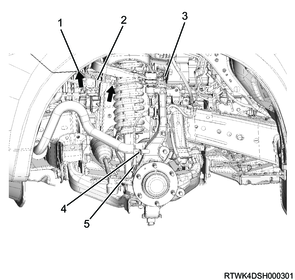
Legend
- Connector position
- Wheel speed sensor
- Harness bracket tightening nut
- Harness bracket tightening bolt
- Wheel speed sensor tightening bolt
4) Connect the harness connector to the wheel speed sensor.
5) Make sure that the harness is not twisted.
4. Inspection after vehicle restoration
1) Turn ON the ignition switch, and check whether the ABS warning light turns OFF after illuminating for approximately 3 seconds.
2) Start the engine and drive the vehicle straight forward from a stationary state. Slowly accelerate to 15 km/h {9.3 mph} and then slowly apply the brake until the vehicle stops. Check that there are no abnormal noises or problems with the braking force during this procedure.
3) Confirm whether the following symptom occurs during verification actions above.
- The ABS warning light illuminates, or does not illuminate.
- ABS operation noise or motor rotation noise is caused.
- Brake pedal kickbacks are felt.
- Desired braking force is not reached.
4) When the above symptom occurs, take the following action.
- Check the installation status of the wheel speed sensor and connection status of the connector.
- Check the DTCs, and perform inspection and take remedies for the ABS system in accordance with the diagnostic procedure for each DTC.
Caution
- Since the ABS rotates the motor for a moment right immediately after the vehicle is started, sound of rotating motor may be heard. This operation for initial confirmation task and not at fault.
13. Power steering unit connect
1) Connect the tie rod end to the knuckle.
2) Install the castle nut to the ball joint.
Tightening torque: 98 N・m { 10.0 kgf・m / 72 lb・ft }
3) Install the cotter pin to the ball joint.
Caution
- Do not reuse the cotter pin.
14. Outside drive shaft installation
1) Fill the outside drive shaft double offset joint section with grease.
Standard: 135 g { 4.8 oz }
2) Install the outside drive shaft to the inside drive shaft.
3) Move the outside drive shaft double offset joint section in the vertical direction several times.
4) Install the circlip to the double offset joint case.
Note
- Install so that the circlip open end is away from the ball groove of the double offset joint case.
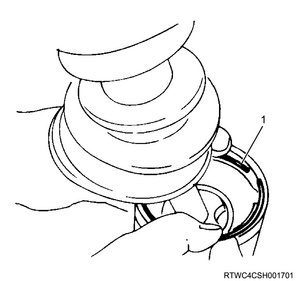
Legend
- Circlip
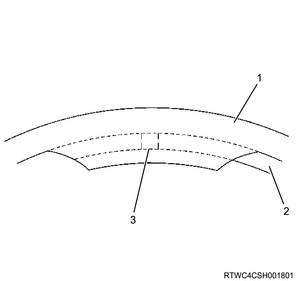
Legend
- Double offset joint case
- Circlip
- Open edge
5) Install large boot band A to boot A.
Caution
- Do not reuse large boot band A.
- Install large boot band A in the correct direction.
6) Stake large boot band A using the special tool.
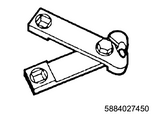
SST: 5-8840-2745-0 - clamp plier
Standard: 0.4 mm or less { 0.016 in or less } Difference between a and b
Standard stake amount
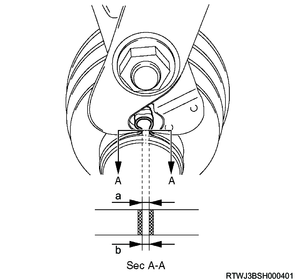
Dimensions
a: 1.2 to 4.0 mm { 0.05 to 0.16 in }
b: 1.2 to 4.0 mm { 0.05 to 0.16 in }
15. Knuckle installation
1) Install the knuckle to the upper control arm.
Tightening torque: 98 N・m { 10.0 kgf・m / 72 lb・ft }
2) Install the cotter pin upper control arm.
Caution
- Do not reuse the cotter pin.
3) Connect the lower ball joint to the knuckle.
Tightening torque: 147 N・m { 15.0 kgf・m / 108 lb・ft }
4) Install the cotter pin to the lower ball joint.
Caution
- Do not reuse the cotter pin.
5) Referring to the following, adjust the trim height.
Refer to "3.Driveline, Axle 3C.Drive Shaft System wheel alignment check".
16. Dust cover installation
1) Install the dust cover to the knuckle.
17. Front hub installation
1) Install the front hub and brake rotor to the knuckle.
2) Install the bolt to the knuckle.
Tightening torque: 85 N・m { 8.7 kgf・m / 63 lb・ft }
3) Install the washer and lock nut to the front hub.
Tightening torque: 127 N・m { 13.0 kgf・m / 94 lb・ft }
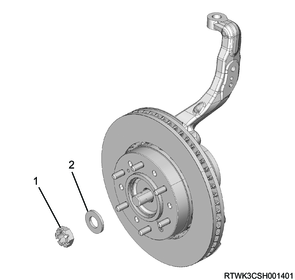
Legend
- Lock nut
- Washer
4) Install the cotter pin to the front hub.
Caution
- If the cotter pin hole position does not align, rotate the lock nut in the tightening direction to align it.
5) Install the hub cap to the front hub.
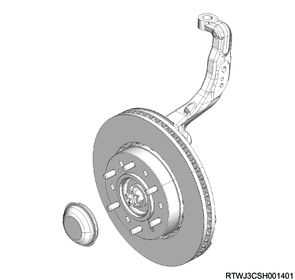
18. Brake caliper installation
1) Install the brake support to the knuckle.
Tightening torque: 205 to 245 N・m { 20.9 to 25.0 kgf・m / 151 to 181 lb・ft }
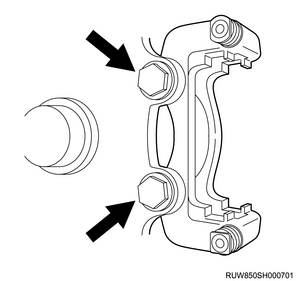
2) Install the disc brake pad and shim to the brake support.
3) Install the brake caliper to the brake support.
4) Install the lock bolt to the brake caliper.
Tightening torque: 32 to 42 N・m { 3.3 to 4.3 kgf・m / 24 to 31 lb・ft }
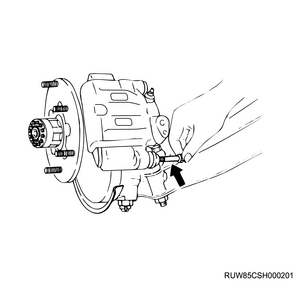
19. Shift on the fly actuator installation
1) Clean the contact surface of the housing and shift-on-the-fly actuator.
2) Apply LOCTITE FMD-127 or equivalent to the contact surface between the shift-on-the-fly actuator and the housing.
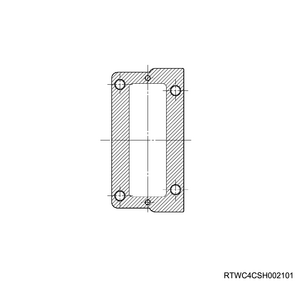
3) Remove any old sealing agent from the bolt and threaded hole.
4) Apply LOCTITE FMD-127 or equivalent to the bolt.
5) Install the shift-on-the-fly actuator to the housing.
Tightening torque: 9 N・m { 0.9 kgf・m / 80 lb・in }

20. Front propeller shaft installation
1. Precautions when installing the front propeller shaft
Caution
- Always install according to the alignment marks that were made during removal.
- Always install the propeller shaft body and spline yoke so that they face the same direction.
- If foreign material such as black paint, grease, oil, or paint is attached to the flange yoke mounting surface, clean it.
2. Front propeller shaft installation
1) Install the front propeller shaft to the front axle and transfer flange.
Tightening torque: 59 N・m { 6.0 kgf・m / 44 lb・ft }
Note
- Install according to the alignment marks applied during removal.
2) Apply black paint to all the exposed surface excluding the flange coupling bonding section.
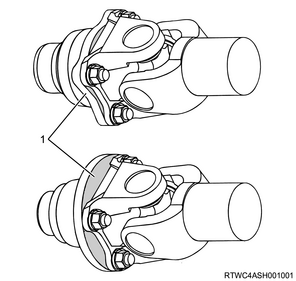
Legend
- Exposed portion of the flange coupling
3. Front propeller shaft grease filling
1) Fill the front propeller shaft with grease from the following locations.
- The 2 universal joint locations
- The 1 sliding sleeve location
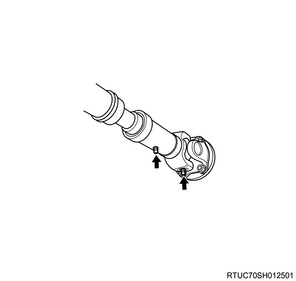
Caution
- Referring to the following, fill with grease regularly.
Refer to "201.General Information 14B.Vehicle Information maintenance schedule".
21. Disc wheel installation
1. Models with aluminum wheels
1) Temporarily tighten the disc wheel to the vehicle.
2) Lower vehicle.
3) Final tighten the wheel nut in the order shown in the diagram.
Tightening torque: 120 N⋅m {12 kgf⋅m / 87 lb⋅ft}
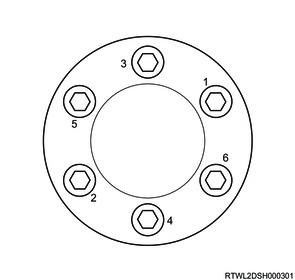
Caution
- After completing installation, make sure to further tighten the wheel nuts to the specified torque after the vehicle has been driven a distance exceeding the standard value.
Standard: 50 to 100 km { 31 to 62 mile }
4) Install the wheel cap to the disc wheel.
Note
- For models with 18-inch aluminum wheels, align the wheel cap groove with the air valve before installing.
5) Check that the surfaces of the wheel cap and wheel are flat.
Note
- If the surfaces are not flat, the wheel cap may fall off.
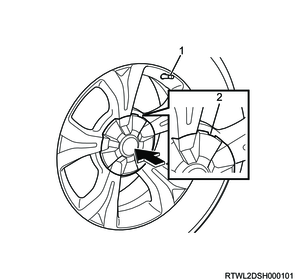
Legend
- Valve
- Wheel cap groove
2. Models with steel wheels
1) Temporarily tighten the disc wheel and wheel cap to the vehicle.
2) Lower vehicle.
3) Final tighten the wheel nut in the order shown in the diagram.
Tightening torque: 120 N⋅m {12 kgf⋅m / 87 lb⋅ft}

Caution
- After completing installation, make sure to further tighten the wheel nuts to the specified torque after the vehicle has been driven a distance exceeding the standard value.
Standard: 50 to 100 km { 31 to 62 mile }
22. Differential oil filling
1. Regarding lubricant refill amount and type
For the lubricant refill amount, refer to the following.
Refer to "204.Driveline, Axle 17B.Maintenance Information primary specifications of driveline, axle".
For the lubricant type, refer to the following.
Refer to "201.General Information 14B.Vehicle Information recommended fluids, lubricants and diesel fuels".
2. Front final drive lubricant refill procedure
1) Install the drain plug and gasket to the front drive axle.
Tightening torque: 50 N・m { 5.1 kgf・m / 37 lb・ft }
Caution
- Do not reuse the gasket.
2) Add differential oil to the front drive axle.
Note
- Fill oil up to the lower surface of the filler plug hole.
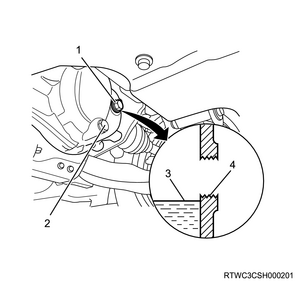
Legend
- Filler plug
- Drain plug
- Oil surface
- Hole lower edge
3) Install the filler plug and gasket to the front drive axle.
Tightening torque: 50 N・m { 5.1 kgf・m / 37 lb・ft }
Caution
- Do not reuse the gasket.
23. Shift on the fly system oil filling
1. Regarding lubricant type
For the lubricant type, refer to the following.
Refer to "201.General Information 14B.Vehicle Information recommended fluids, lubricants and diesel fuels".
2. Lubricant refill procedure
1) Remove the filler plug and gasket from the housing.
2) Add shift-on-the-fly system oil to the housing.
Note
- Add oil up to the lower edge of the hole.

Legend
- Filler plug
- Right front tire
- Oil surface
- Lower surface of the hole
3) Install the filler plug and gasket to the housing.
Caution
- Do not reuse the gasket.
Tightening torque: 50 N・m { 5.1 kgf・m / 37 lb・ft }
24. Underguard installation
1. Models with front and rear underguards (long type)
1) Install the front underguard to the frame.
Tightening torque: 42 N・m { 4.3 kgf・m / 31 lb・ft }
2) Install the rear underguard (long type) to the frame.
Tightening torque: 42 N・m { 4.3 kgf・m / 31 lb・ft }
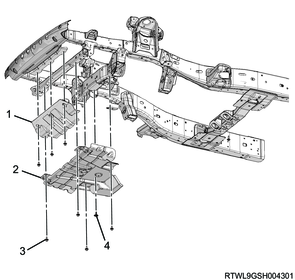
Legend
- Front underguard
- Rear underguard (long type)
- Bolt
- Clip
2. Models with front and rear underguards (short type)
1) Install the front underguard to the frame.
Tightening torque: 42 N・m { 4.3 kgf・m / 31 lb・ft }
2) Install the rear underguard (short type) to the frame.
Tightening torque: 42 N・m { 4.3 kgf・m / 31 lb・ft }
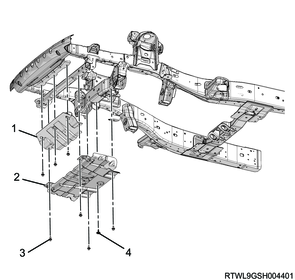
Legend
- Front underguard
- Rear underguard (short type)
- Bolt
- Clip
3. Models with front and rear underguards and oil pan guard.
1) Install the front underguard to the frame.
Tightening torque: 42 N・m { 4.3 kgf・m / 31 lb・ft }
2) Install the rear underguard to the frame.
Tightening torque: 42 N・m { 4.3 kgf・m / 31 lb・ft }
3) Install the oil pan guard to the frame.
Tightening torque: 42 N・m { 4.3 kgf・m / 31 lb・ft }
Models with hydraulic power steering
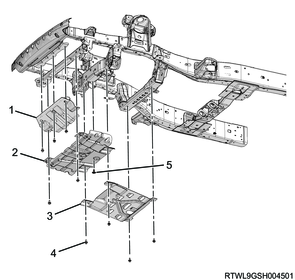
Legend
- Front underguard
- Rear underguard
- Oil pan guard
- Bolt
- Clip
Models with electric power steering
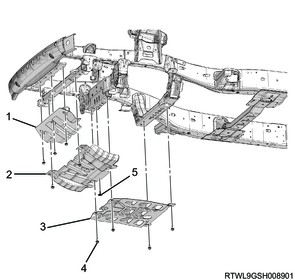
Legend
- Front underguard
- Rear underguard
- Oil pan guard
- Bolt
- Clip
25. Wheel alignment check
26. Preliminary and post procedures
1. Post procedures
1) Connect the battery cable to the battery negative terminal.
2) Referring to the following, perform the setting of the front door power window switch with AUTO UP/AUTO DOWN function.
3) Close the engine hood.